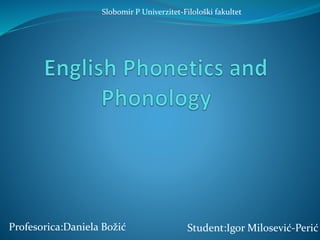English phonetics and phonology
•Als PPTX, PDF herunterladen•
0 gefällt mir•990 views
Fonetika
Melden
Teilen
Melden
Teilen

Empfohlen
Grundbegriffe der Wortbildungslehre: Morpheme, Morphemtypen, freie Morpheme, Konfixe und unikale Morpheme, Wortbildungsmorpheme, Simplizia und Wortbildungskonstruktionen, Suffixe und Präfixe, untrennbare und trennbare Präfixe, semantische Modifikation und syntaktische Transposition, Verbalpartikeln u. v. a. m.Grundbegriffe der Wortbildungslehre - aktualisierte und erweiterte Version de...

Grundbegriffe der Wortbildungslehre - aktualisierte und erweiterte Version de...Jelena Kostic-Tomovic
Weitere ähnliche Inhalte
Was ist angesagt?
Grundbegriffe der Wortbildungslehre: Morpheme, Morphemtypen, freie Morpheme, Konfixe und unikale Morpheme, Wortbildungsmorpheme, Simplizia und Wortbildungskonstruktionen, Suffixe und Präfixe, untrennbare und trennbare Präfixe, semantische Modifikation und syntaktische Transposition, Verbalpartikeln u. v. a. m.Grundbegriffe der Wortbildungslehre - aktualisierte und erweiterte Version de...

Grundbegriffe der Wortbildungslehre - aktualisierte und erweiterte Version de...Jelena Kostic-Tomovic
Was ist angesagt? (20)
Nasals and other consonants group 1 marissa & zuki

Nasals and other consonants group 1 marissa & zuki
Grundbegriffe der Wortbildungslehre - aktualisierte und erweiterte Version de...

Grundbegriffe der Wortbildungslehre - aktualisierte und erweiterte Version de...
The proposal of advanced syntax, especially in binding theory

The proposal of advanced syntax, especially in binding theory
ELKL 5 Language documentation for linguistics and technology

ELKL 5 Language documentation for linguistics and technology
Ähnlich wie English phonetics and phonology
Ähnlich wie English phonetics and phonology (20)
Kürzlich hochgeladen
Mehran University Newsletter is a Quarterly Publication from Public Relations OfficeMehran University Newsletter Vol-X, Issue-I, 2024

Mehran University Newsletter Vol-X, Issue-I, 2024Mehran University of Engineering & Technology, Jamshoro
https://app.box.com/s/7hlvjxjalkrik7fb082xx3jk7xd7liz3TỔNG ÔN TẬP THI VÀO LỚP 10 MÔN TIẾNG ANH NĂM HỌC 2023 - 2024 CÓ ĐÁP ÁN (NGỮ Â...

TỔNG ÔN TẬP THI VÀO LỚP 10 MÔN TIẾNG ANH NĂM HỌC 2023 - 2024 CÓ ĐÁP ÁN (NGỮ Â...Nguyen Thanh Tu Collection
Kürzlich hochgeladen (20)
HMCS Max Bernays Pre-Deployment Brief (May 2024).pptx

HMCS Max Bernays Pre-Deployment Brief (May 2024).pptx
This PowerPoint helps students to consider the concept of infinity.

This PowerPoint helps students to consider the concept of infinity.
UGC NET Paper 1 Mathematical Reasoning & Aptitude.pdf

UGC NET Paper 1 Mathematical Reasoning & Aptitude.pdf
Python Notes for mca i year students osmania university.docx

Python Notes for mca i year students osmania university.docx
TỔNG ÔN TẬP THI VÀO LỚP 10 MÔN TIẾNG ANH NĂM HỌC 2023 - 2024 CÓ ĐÁP ÁN (NGỮ Â...

TỔNG ÔN TẬP THI VÀO LỚP 10 MÔN TIẾNG ANH NĂM HỌC 2023 - 2024 CÓ ĐÁP ÁN (NGỮ Â...
Fostering Friendships - Enhancing Social Bonds in the Classroom

Fostering Friendships - Enhancing Social Bonds in the Classroom
Unit-V; Pricing (Pharma Marketing Management).pptx

Unit-V; Pricing (Pharma Marketing Management).pptx
ICT role in 21st century education and it's challenges.

ICT role in 21st century education and it's challenges.
English phonetics and phonology
- 1. Student:Igor Milosević-PerićProfesorica:Daniela Božić Slobomir P Univerzitet-Filološki fakultet
- 2. Content: Close front and close back vowels Difference in strong and weak syllables Syllabic l Syllabic n Syllabic m and ŋ Syllabic r
- 3. Close front and close back vowels Close front vowels are i and i: and we can find them occuring: i. In word-final position in words spelt with final y or ey (after one or more consonant letters) e.g ‘happy’ hæpi, valley væli and in morpheme-final words when such words haves suffixes beginning with vowels, e.g easiest i:ziəst ii. In a prefix such as those spelt ‘re’ ‘pre’ ‘de’ that precedes a vowel and is unstressed, e.g ‘react’ riækt,’proccupied’ priɒkjʊpaid iii. In the suffiexes spelt ‘ious’ ‘iate’, when they have two syllables, e.g ‘hilarious’ hileəriəs iv. In the following words when unstressed ‘he’ she’ ‘we’ ‘me’ ‘be’, and a word ‘the’ when it precedes a vowel.
- 4. Difference in strong and weak syllables In strong syllables it is comparatively easy to distinguish i from i: and, u from u: , for example feet and fit, but in weak syllables it is much less easy to hear the difference. We can see this in: Easy Busy i:zi: bizi: I:zi bizi This is not phonemic transcription in traditional sense , but it is best accepted by the native speakers.
- 5. Syllabic l Syllabic l is the most noticeable example of English syllabic consonant.In words with a preceding consonant such as bottle, tunnel we have lateral release.The l is a “dark l”. In RP we can usually find it in the words that have one or more vowel preceding suffix –le.Examples are: i. With alveolar consonant preceding ;‘cattle’ kætl ‘bottle’ bɒtl ii. With non-alveolar consonant preceding ;’couple’ kʌpl ‘trouble’ trʌbl
- 6. Syllabic n Is most commonly found after plosive and fricative sound, in the case of t and d followed by n the plosive is nassaly released by lowering of the soft palate e.g. ‘eaten’ i:tn In words where syllabic consonant is followed by ‘an’ or ‘on’ it is rarely heard e.g. wagon wægən After bilabial consonants it is considered equally acceptable to use n or ən e.g. ‘ribbon’ ribən After f and v , n is more usual than ən e.g ‘seven’ sevn Clusters with nasal+plosive+syllabic nasal are very unusual e.g ‘London’ lʌndən
- 7. Syllabic m and ŋ We find them sometimes in words like ‘happen’ which could be transcribed as hæpm or hæpn and upper- most could be pronounced like ʌpməust although ʌpəməust is more usual pronounciation Examples of syllabic velar nasals are ‘thicken’ θikŋ and ‘broken key’ brəukŋ ki: where the nasal consonant occurs between velar consonant.
- 8. Syllabic r In accents of the type called ‘rhotic’ such as most American accent syllablic r is very common. Syllabic r is less common in RP and there are acceptable pronounciations without the syllabic consonant.Here are some examples: a) Where non-syllabic r is acceptable;history histri (not usually histəri) b) Where ər is also acceptable; ‘buttering’ bʌtriŋ There are couple minimal pairs in wich meaning of the word depends wether r is syllabic or not; ‘Hungary’ hʌŋgri ‘hungry’ hʌŋgri